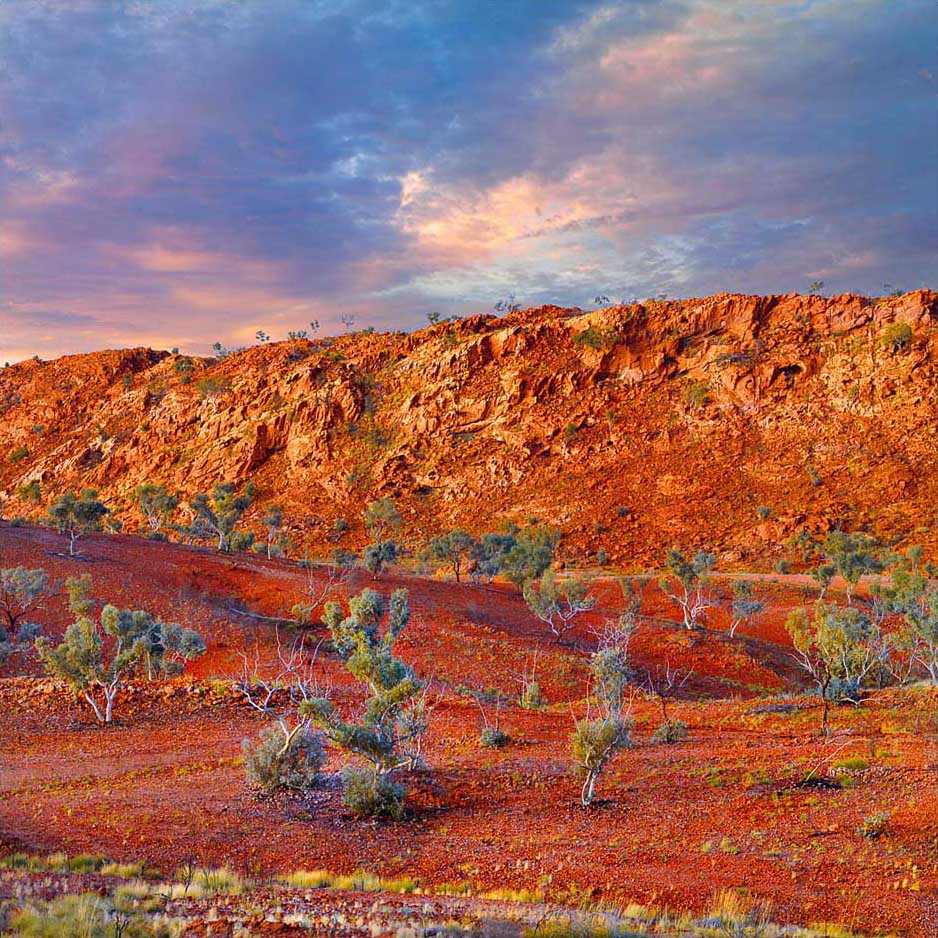The walls of the world, Pigment print, 127cm x 127cm, 2012
I am fascinated in the broadest sense by landscapes like the Pilbara, including my ignorance and insensitivity to them. I’m not ‘in the Pilbara’ in the way that scientists collect and identify its objects. Rather I am collecting what can’t be seen; evidence of my uncertainty, my interaction, my wanderings and pondering.
But what do I really know of this far away place? Very little except that it is remote and ancient, a place of extremes, both climate and distance, and cultural dislocation. What do I discover about my settler culture, my artistic presumptions, my myths and prejudices? What do I suspect I am doing, and what am I responsible for?
I’m drawn to its boundaries and edges; between solid and liquid, weight and weightlessness, hot and cool, dry and wet, between ourselves and the rest of the world, and that line of habitation that encrusts, indeed misrepresents our nation.
For the Pilbara carries a stain or residue that is at the heart of its troubled relationship with urban Australia. The problem is how we index, moralise and politicise land use, rather than appropriating or projecting country as an aesthetic object. ‘History’ pales against ‘three and a half billion years on the surface of the earth’. The terrain shifts while the ground remains the same.
I would hope to make pictures that acknowledge this struggle and dislocation, that point to what is possible or unlikely, and mimic a more general theory of habitation; including the myths I incite, the paving I import, and the gate keeping I impose. There is also the fascination with the unanswered questions and what it means to become entangled in their complexity and construction. Not only the conflicts and contradictions but the fact that I am on stolen land, not my country, and what it means to acknowledge and engage with such strangeness ‘in your own back yard’.
I see only what I know. I respect only what I understand. What I need is an ethics for decolonisation. I have a lot of ground to recover.



{ 1 comment… read it below or add one }
I wonder if respect needs to be based on understanding. If that position is extended, perhaps then our own cognitive development limits that which is to be understood.
I have been most impressed by faith based respects – most recently by a Bishop who puts faith, love and respect ahead of all else. In fact – that statement is wrong – for he has BECOME faith, love and respect. It is from that entirely non defensive and all embracing connection he has with the world that he sees all. He spoke at the opening of my second to last exhibition, and I was staggered by what he knew, what he felt and saw – and his capacity to place that into a global context.
For me – this is like Suzuki’s exploration in the 1970’s where he tried to find the place at which human breathing/ circulation systems stopped and oxygen started. He could not find that place and concluded that the air simplyy flowed through us all, leading to the famous conclusion – there is no point at which it ends and we start – in that sense, we are all the air..
It is so fitting that your beautiful image comes from that very Australian place currently being turned into a gravel pit – a vast crater from which all riches will be harvested. The whites who own the leases are becoming the richest people in the world, government abregate their constitutional obligation – and justify the allocation of rights to native titleholders with the promise of education and facilities. Presumably without Rio Tinto, the people on the Dampier Peninsula would be completely neglected by the WA Government altogether. No schools, no medical, no shops or infrastructure.
Government will only be happy, when every traditional owner has a mortgage, 2 car leases and some white goods on hire purchase and is committed to taxpaying for the rest of their lives. Already it has started, and government attendance to smaller communities is being throttled back, forcing families to the overstressed large population centres like Fitzroy Crossing, where the ravages of a disconnected and spiritually dismembered life turns each day into a train wreck leaving financial books in teasury in better shape, but with human costs unimagineable.
Silence – except for the marginal heroics – is bought through a few decade capped royalties. The mess, and the human fall-out from those royalty payments is obscene. We ckaim to hate foreign acts of genocide – the Bosnian situation for example – yet Australians have for the past 200 years quietly got on with the job of cultural erasing. It goes on under our watch.
I dont know about the ethics of decolonisation. In my view, we have the collective maturity of a self destructive adolescent. En masse, wreaking havoc with our precious assets – on the basis that we are indestructable. The truth is, just as it is for individuals – when we do eventually all grow up, the years of excess will have taken their toll far beyond our current understanding.
80% of the Queensland catchment area for the Murry is slated for coal seam. As Australia exports the harvested riches, our dollar goes through the roof, strangling primary producers – who are selling their land to the Chinese, the Indians and the Japanese who see the global food shortage as their opportunity. Its cheaper to buy off shore – and consequently one can buy mexican oranges in Mildura cheaper than the local fruit, which is being bulldozed into the ground. Our modern day gold rush is asphyxiating us.
In companies led by the decisive – when there is a problem with performance – all those contributing to the problem are behaviourally corrected, or ‘rehabilitated elsewhere’. The quickest and only way to transform a business is to gut it.
In our world, and somehow linked to your superb image – the only way to preserve our nation and those assets we seek to claim, (but dont belong to us)
is to exit all those who are authors of the current position.
We will end up taking an axe to ourselves.